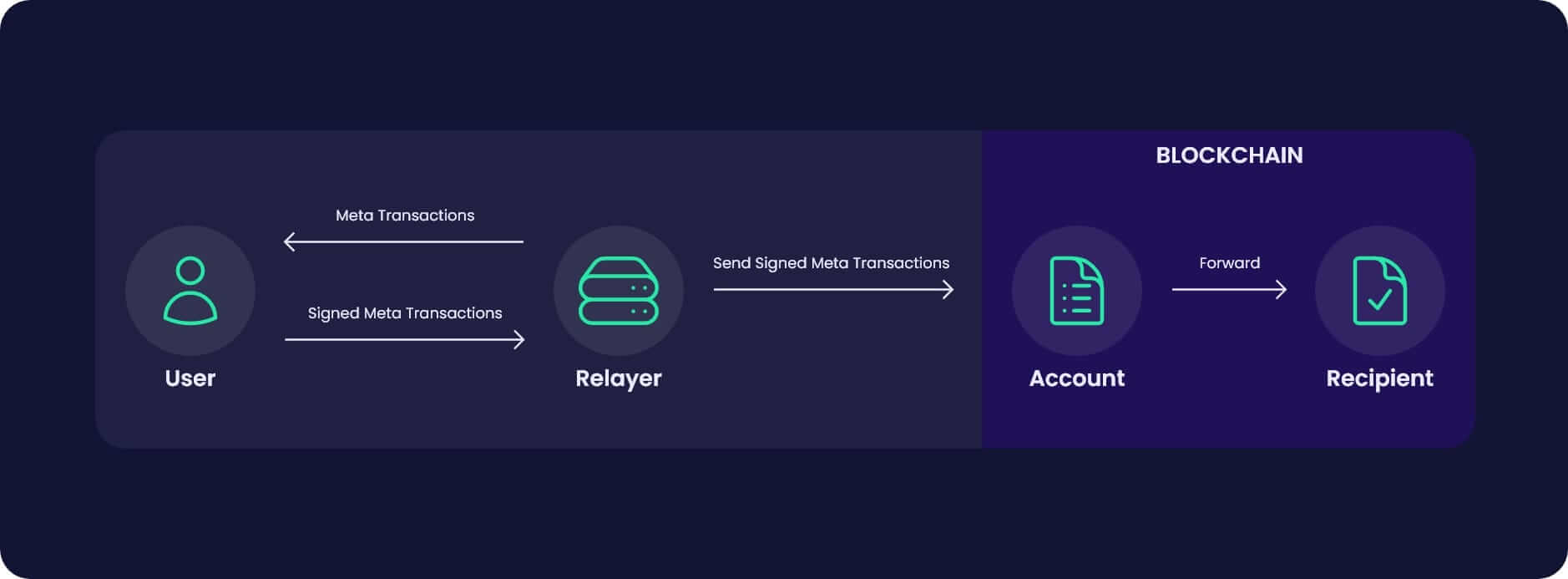Understanding Meta Transactions
Explore the transformative power of meta transactions in Ethereum, breaking down barriers for new users and streamlining blockchain interactions for all.

The usability of decentralized applications on Ethereum and other Layer 2 blockchains is often hindered by the need for gas, the fuel for transactions on the network. This requirement for users to hold Ether (or other native tokens) creates a significant entry barrier. Meta transactions offer a seamless, efficient alternative to traditional methods, enhancing user experience and accessibility. This guide aims to demystify meta transactions, exploring their mechanisms and their practical applications in Web3. As we delve into this topic, we'll highlight how Ambire Wallet utilizes these advancements to transform the crypto transaction experience.
What are meta transactions?
In simple terms, think of them as extended, more powerful versions of standard transactions. They allow you to perform actions on the blockchain without directly paying for the gas fees each time. This is particularly beneficial for new users who might find gas fees daunting, especially if these need to be paid in the network’s native token but you’re trying to swap USDC for WALLET, e.g.
In technical terms, in ERC-4337, userOps are a form of meta transactions.
Unlike traditional transactions, where you pay the gas fee at the time of its execution, meta transactions handle these costs differently. They enable a third party, a.k.a relayer or paymaster, to pay the gas fee on behalf of the user, who can then settle this cost at a later stage or through alternative means. This approach simplifies the transaction process and opens new possibilities for decentralized applications (dApps) and services.
Originally, meta transactions were implemented in a dApp level (see ERC-2771). With the rise of Аccount abstraction, the definition of meta transactions becomes looser, and you can say that every form of transaction that isn't a native Ethereum transaction but offers some extra features or abstraction is a meta transaction.
How do meta transactions work?
Meta transactions streamline Ethereum interactions by separating the user's action from the gas fee payment, involving both off-chain and on-chain processes. Initially, the user signs a transaction off-chain and sends it to a relayer. This relayer, a third-party service, wraps or translates the user's transaction into a native transaction and forwards it to a forwarder contract on the Ethereum blockchain.
The account contract, acting as an intermediary, verifies the user's signature and transaction validity and performs the authorized actions. The recipient contract executes the user's action, while the relayer handles the gas fees, which can be reimbursed by the user later. Ambire Wallet, for example, has an innovative, unique feature called the Gas Tank that allows for prepaying transfer fees. You can top up a wide variety of stablecoins or native tokens on one network and use them to pay on all supported networks by the wallet. The best part is you save over 20% of transaction fees and get cashback.

Types of meta transaction relayers
Meta-transactions can be facilitated through two primary types of relayers: centralized and decentralized. Each type offers distinct advantages and operates under different paradigms, catering to varied user needs and application scenarios.
Centralized Relayers
Centralized relayers involve a single entity or organization managing the transaction relay process. This approach often results in a more streamlined and user-friendly experience, as the relayer can optimize the process for efficiency and ease of use. A prime example of a centralized relayer is the one Ambire Wallet uses. Ambire's relayer simplifies transactions for its users by managing the complexities of gas fees and transaction forwarding. Having a centralized relayer isn’t bad because the account itself is still decentralized and only secured by your own keys.
Decentralized Relayers
On the other hand, ERC-4337 proposes a shift from centralized to decentralized relayers in managing Ethereum transactions, emphasizing a more distributed approach. This proposal envisions a system where transaction processing is spread across numerous nodes or participants. It offers enhanced trustlessness and resistance to censorship. While the Gas Station Network (GSN) represents an earlier notable implementation of decentralized relayers, with various nodes acting as relayers and giving users the choice of transaction forwarders, ERC-4337 takes this further. It ensures no single entity controls the transaction process, bolstering security and maintaining the core principles of decentralization inherent in blockchain systems.
Ambire Wallet's implementation of meta transactions
Ambire Wallet is a pioneer in smart accounts and Account abstraction wallets, particularly in its innovative implementation of meta transactions. This feature has helped Ambire become the leading wallet in terms of transaction volume on the Ethereum network.
At the core of Ambire Wallet's functionality is its relayer, which plays a crucial role in facilitating meta transactions and has allowed us to implement all Account abstraction benefits before ERC-4337 even went live. We’ve been developing and perfecting this technology since 2017, and it has more than withstood the test of time. The Ambire relayer allows users to perform transactions without needing ETH (or other native tokens) for gas fees, something which has proven to be a significant barrier for many new users. Instead, gas fees can be paid in the token being transacted with (or another stablecoin or token altogether), simplifying the process and broadening accessibility.
Ambire Wallet is currently ERC-4337 compatible and will offer native support for it in the upcoming browser extension, which is set to revolutionize how meta transactions are handled by phasing out the need for a relayer. This change will be brought about by introducing alternative mempools for smart wallet-level transactions (UserOp) and paymasters, which enable gas abstraction.
These are just a few of the features that Ambire employs for meta transactions. Furthermore, Ambire Wallet offers power features like transaction batching and transaction simulation, enhancing efficiency and user experience. You are able to combine multiple transactions (as much as the block would allow) and broadcast them as one to the blockchain. This doesn’t just significantly improve the user experience but also can reduce the transaction fee paid by as much as 35%! Not only that, but you can also preview the outcome of a transaction before you even sign it - which increases the security of your funds, too, as it prevents you from signing malicious transactions aimed at emptying your wallet, e.g.
The Gas Tank feature is another much-loved feature unique to Ambire Wallet. It allows you to prepay for gas, thus saving on potential costs and earning cashback. You can top it up with a number of stablecoins and other tokens, and then you can use the funds to pay for transaction fees across any supported EVM network. This feature, coupled with the ability to replace and cancel transactions, gives users unprecedented control and flexibility in their blockchain interactions.
Conclusion
Meta transactions are reshaping the blockchain landscape, offering a more accessible and efficient experience for users. Addressing the complexities of traditional transactions is pivotal in driving the wider adoption of blockchain technology. Ambire Wallet exemplifies this shift, leveraging meta transactions to simplify user interactions and prepare for future advancements like ERC-4337. As we witness the continuous evolution of blockchain, meta transactions really stand out as a key innovation, heralding a new era of user-centric and streamlined transaction and digital asset management.
Interested in Ambire? Follow us:
Discord | X (Twitter) | Reddit | GitHub | Telegram | Facebook
